There’s something glorious about disappearing into the mountains, alone.
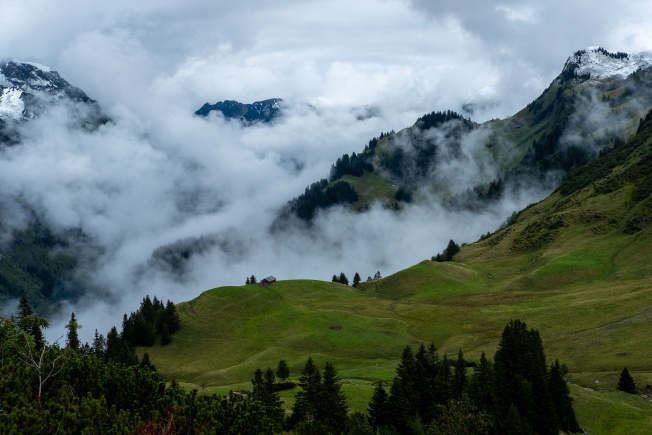
One rainy Sunday last September, I started out from Oberstdorf, a ski village right on the German-Austrian border, along the Allgäuer Höhenweg. The forecast said to expect 32 mm of rain, and when I started, I was prepared to arrive at the hut that night still dripping. But then I climbed, up and up, and at a certain point, the rain started to get kinda… drier? And then fluffier, and then before I knew it, I was hiking in the snow.
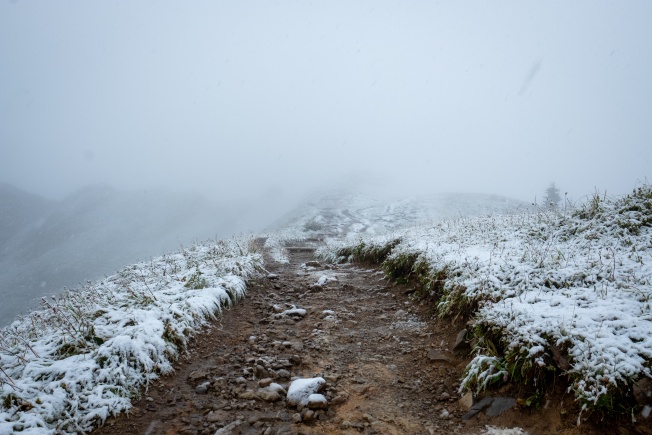
I probably should have anticipated it? But I grew up on the east coast of Australia, where it’s warm and flat, and so you inherit a naïvety about this interplay between precipitation and altitude. I came to an experiential understanding over the next two days as I climbed mountains and descended into valleys, as I crossed from green, to snow, to green again.
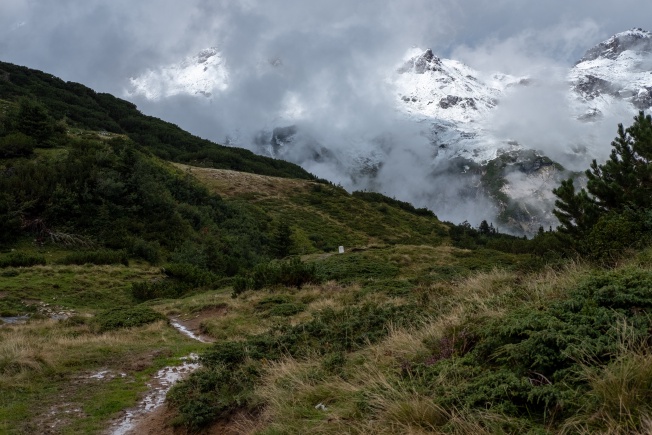
The problem with snow isn’t so much that it makes the hiking hard, but that it makes it hard to find the trail. The path itself is often completely snowed over, the visibility is bad, and worst of all, the trail markers, which are painted onto rocks along the way and are normally super easy to find, are often entirely obscured. So you find yourself wiping snow off the rocks and hoping to see red paint underneath.
I remember consciously deciding not to pack gloves. I hadn’t really found them useful on previous hikes; it wasn’t ever really that cold during the day. I remembered that decision bitterly as I was wiping snow off the rocks looking for markers.
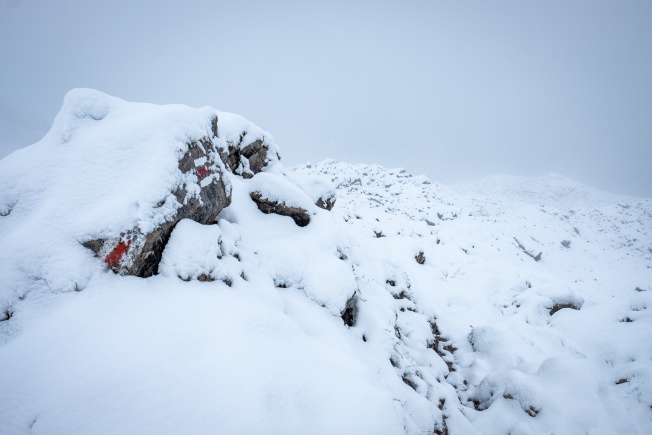
Trail markers. I guess there’s a trail there too, somewhere.
So, on the second day at 7:30am, I opened the Hut door and stepped out.
The man smoking on the porch turns to me and says, “I don’t know if you’re going to be able to find the path in all this snow”. I tell him I’ll take a quick look around, and then come back if it doesn’t look possible.
There’s a signpost about 50 meters from the Fiderepasshütte with signs pointing in directions of all the nearby trails and huts. I look in the direction of the sign pointing to the Mindelheimer Hütte. There’s definitely not a path anymore, but you can see like a weirdly smooth flat bit snaking off into the distance. And then, the faintest outline of… shoeprints? But, that didn’t make sense; it had been snowing all night, so they couldn’t possibly have been from yesterday, and I was pretty sure I was the first person to leave the hut this morning.
I follow them anyway. If you start early enough, and you have a map and a GPS, you can usually find your way back. It’s a calculated risk.
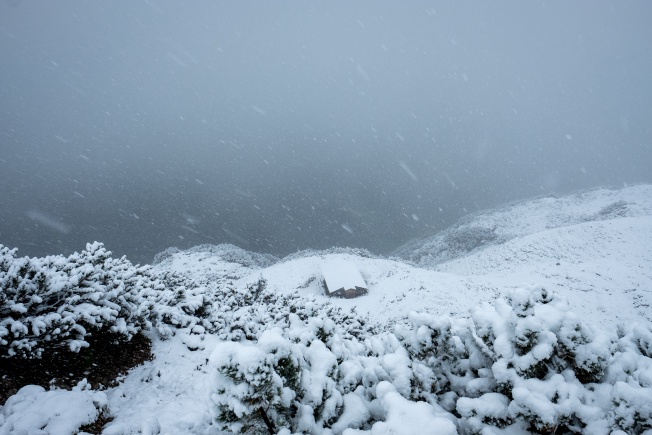
The first two hours that morning were through the snow. Slowly, slowly. Follow the footprints. Look carefully to make sure there’s only one set, especially in places where there could have been a fork. Look for those faint, raised bumps, like scars in the snow-skin, which indicate where trails used to lie. Rejoice at the discovery of a marker, or a signpost. Check the GPS-map and make sure that you haven’t strayed too far from the path – but, don’t trust it too much, they’re not often perfect in their accuracy, and the path that makes sense in the snow isn’t always the same that makes sense in the dry.
And then, descend far enough that the snow starts to turn back to sleet, and the trail turns to mud. You’ve done it. See some travellers coming from the Mindelheimer Hütte. “It’s not so far now!”
You become extremely grateful for these travellers coming from the other direction when you’re trekking through the snow. Seeing footprints coming towards you gives you a unique perspective on the path – maybe there’s a marker painted onto the other side of that rock, but the one on your side is covered. Maybe they couldn’t find a marker, but at least you know that this stretch of snow is safe-ish and is probably going in the right direction, because they must have come from somewhere.
When you’re following footsteps, you have this uncanny awareness that you’re following the ghost-tracks of a person you don’t know, and will probably never meet (but maybe you met them already, at the hut last night?). Regardless, you’re grateful that they were there before you to show you the way, and you hope that they made it to wherever they were going.
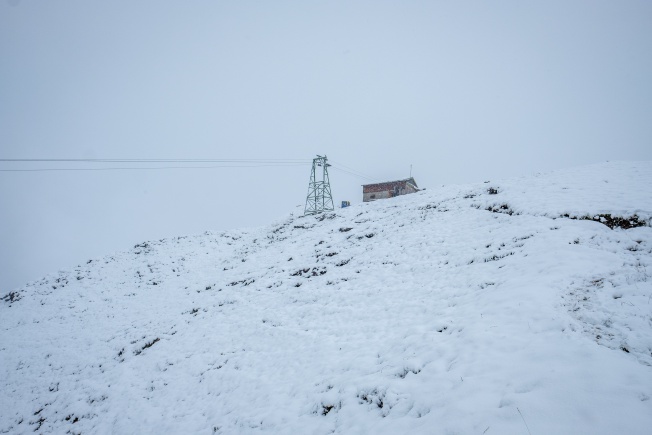
The Materialseilbahn (cargo cable car) at the Mindelheimer Hütte.
After two-and-a-half hours, arrive at the Mindelheimer Hütte. Meet two women who are just leaving.
“Did you come from the Fiderepasshütte?”, they ask.
“Yeah”, I say. “Are you heading there now?”
“No, we came from there this morning!”
It sinks in: “Wait… those were your footprints I was following this morning?”
“Yeah, we left at six, thinking we might need some extra time to find the way in the snow. We skipped breakfast”.
That was an hour and a half before I’d left.
“Did you get breakfast here?” It’s 10 by this point. Hut breakfast usually finishes about 8am, but maybe they managed something.
“No! We were too late, but they’ve got the soup ready for lunch already. It’s really good.”
“How did you find the path?”, I ask.
“Eh, it wasn’t so bad. We had a map.”
“Like, on your phone? With GPS?”
(Brandishing paper) “No, like this one here. We did have a compass though, that helped.”
I was bewildered, and apparently it showed. Though it could have just been that I’d run out of breath after the walk, or run out of German.
They continue: “Are you heading onwards to the Rappenseehütte?”
“Yeah! I’ll see you there?”
“See you there.” And with that, they leave again.
I stayed a while to warm up, dry off, wait out the snow, and for a hot chocolate and a slice of cheesecake.
As you descend, the need for a ghost-guide lessens. The rest of the hike that day led down into a valley, and up the other side into the mountains again.
Another weather-related surprise – 70 cm of powder snow on top of the mountain translates back to 50 mm of rain, and 50 mm of rain at the bottom of a valley translates to a lot of water, and a lot of water translates to mud, and low cloud. But, at least the path becomes easy to find again.
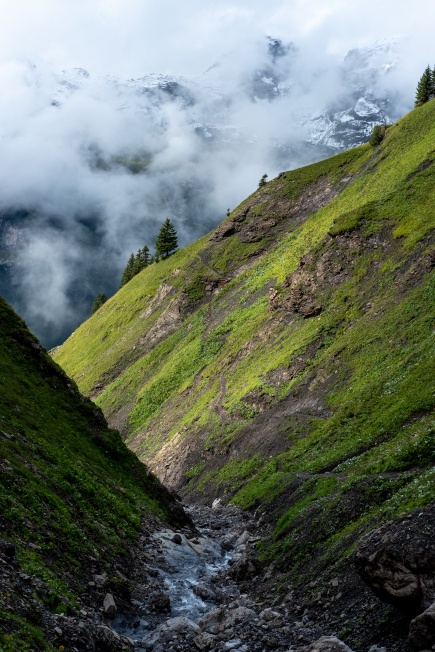
Across the stream, and up the path up to the Rappenseehütte.
At the bottom of the valley, and before the climb back up the other side started again, I met four men, one of whom propped a fence open for me so I could climb under.
“Did you come from the Mindelheimer Hütte?”, he asks. “How does it look up there?”
“Well,” I consider, “it’s a little muddy, and then once you get higher up, there’s a lot of snow.” I laugh, and ask, “Did you come from the Rappenseehütte? What’s the path like up there?”
He thinks a little, and grins. “Well, yeah, I guess first, it’s a little muddy, and then once you get higher up, there’s also a lot of snow.”
These interactions are kinda banal – there wasn’t a lot of information there that either of us couldn’t have guessed. But somehow it’s nice to have a sense of camaraderie, and to meet people who are trying the same stuff that you’re trying. It reassures you that you’re not completely bonkers, and it means that you know you’ll have a ghost to follow when you need it.
The snow was a continued theme over the rest of the week, and certainly a dominant one along the Heilbronner Weg. But, a large number of people, including a Mountain Adventure School, left the Rappenseehütte before me the next day, so there was always a path to follow (adventure schools are a blessing and a curse). There was less of a need for ghost guides through the snow, but I still found myself looking for traces of people who’d walked these paths before. I love the sense of being in the mountains alone, but there’s something great in knowing that you’re walking where others have walked before.
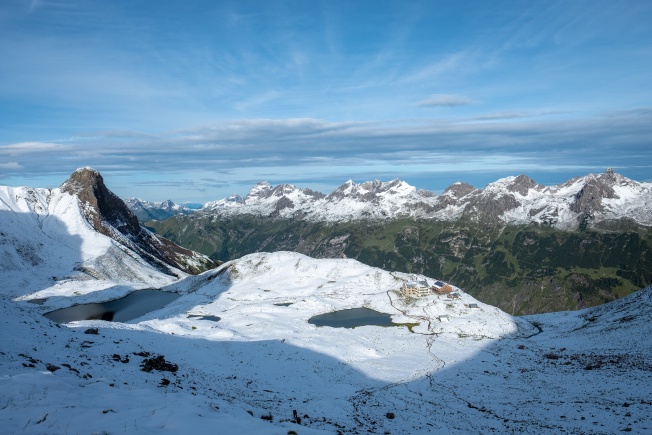
The next day, looking back at the Rappenseehütte on the way up the mountain.